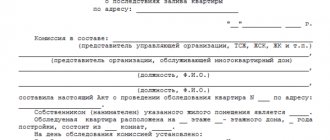By means of an act of damage to property, the fact of damage to the property of an individual or legal entity is documented. The range of legal relations during which there is a need to record the fact of property damage is very wide - from the banal flooding of an apartment to damage to rented property. Files in .DOC: Form of act of damage to propertySample act of damage to property
Grounds for drawing up the act
In the course of civil legal relations, not only citizens or enterprises participate, but also their property. Closely intertwined with property are contracts of supply, transportation, barter, loans, purchase and sale, lease and many others.
Property, like any item in the material world, is subject to wear and tear, damage due to natural causes or damage, both intentional and unintentional.
An act of damage to property is drawn up when the property itself obviously contains traces of a negative impact, namely:
- traces of improper transportation, expressed in dents, chips, damage, etc.;
- traces of improper or careless use of property, for example, scratches on furniture, dirt on wallpaper, broken glass in window or doorways;
- traces of violations of the technology for using property, for example, car springs bursting from overload or a computer burned out without using a UPS.
A common feature of all of the above options is the sign that the property is in the hands of a non-owner. Any person who temporarily owns the owner’s property on the basis of a lease, loan, operational management, transportation of goods or provision of repair services can act as a non-owner.
Manager's reaction to the document
The purpose of creating a report is the need to inform management, therefore it is transferred to the director of the organization, his deputy or other responsible employee, in accordance with local documents. A responsible person must consider the provided note, then make a decision and, through a resolution, start its implementation.
Disciplinary action can only be taken after receiving an explanatory note from the offending employee. However, refusal to draw it up does not mean that management should turn a blind eye to what happened. In any case, the enterprise must initiate an investigation into the facts set out in the document. The goal is to obtain evidence and document the fact of an offense committed by a violator in a special act. Otherwise, the punishment will be illegal and may be challenged by regulatory authorities.
Purpose of the act
Damage to property is almost always the basis for filing financial claims for compensation for damage caused. For this reason, timely and reliable recording of the fact of causing this harm, that is, the fact of damage to property, is extremely important.
We would like to draw the reader's attention to the need to differentiate intentional or unintentional damage from natural wear and tear or damage caused by force majeure.
Differentiation is made by intent or negligence of the person who committed the damage. Intentional damage is difficult to prove, and if it is proven and the damage is significant, then we can talk about the signs of a criminal offense.
Unintentional damage is also a culpable action, but within the framework of a civil tort, that is, civil liability. Differentiating damage from natural wear and tear is difficult, so it is differentiated through specialized examination.
Business entities draw up an act in any case, regardless of the presence of intent or its absence, or the impact of force majeure. It’s just that the text of the act itself notifies the presence or absence of someone’s guilt.
Who is eligible
In general, any employee can write a memo, but in practice the process of drawing up this paper is based on the principle of a hierarchical ladder: that is, the head of a structural unit writes a memo addressed to the manager represented by the general director. In addition to this, the conflict must first be resolved at the local level, with the participation of the head of the unit, and only if he considers it necessary to convey information about the incident to his superiors, a report is drawn up.
The document can be drawn up by another employee, but it will still need to be certified by the immediate supervisor (the nature of the certification is determined by the organization. As a rule, it is enough to put a signature, its transcript and the date of review).
But what to do if the report is written to the immediate (supervisor) manager? Do you still need to obtain a visa from your manager? Of course not. If subordinate employees consider it necessary to convey to the director information about an offense committed by their leader, there is no need for a visa. The paper can be provided to the general director. It is compiled according to the same rules and is designed according to the templates that we have given below.
Drawing up an act
The owner has the right to present material claims for compensation for damage caused to property. Accordingly, the fact of damage is recorded by the owner or his representative (which is typical for legal entities).
Since any act is a commission product, a commission of at least 3 people must be involved in its preparation.
It is allowed to involve invited specialists in drawing up the act if the act is drawn up in relation to damage to high-tech property and the assessment of damage requires special knowledge.
The content of the act of damage to property is not regulated by law, and therefore it is drawn up in an arbitrary manner in compliance with standard norms for maintaining business documentation.
The structure of an act on damage to property does not change depending on the type of legal relationship and includes a number of structural elements that are mandatory for acts in general, namely:
- the name of the document itself;
- date and place of drawing up the act;
- name list of commission members. For acts drawn up by legal entities, an indication of the positions and powers of the commission members will also be required;
- general information about the property that was damaged, including its name, quantity and reasons for which the property was in the use of the guilty person (lease agreement, loan agreement, cargo transportation agreement, etc.). If we are talking about many items of property, then it will be more convenient to arrange the list in the form of a table;
- description of the detected damage;
- amount of damage (as a rule, an approximate cost is indicated, since the amount of damage will be calculated not only based on damage, but also taking into account natural wear and tear). It is acceptable to indicate fixed amounts if items that were not in use were rendered completely unusable, for example, during the transportation of cargo;
- information about the person who is responsible for the damage (tenant, carrier, repair company);
- a general description of the reasons why the damage occurred, for example, wooden coverings were damaged as a result of the construction team using low-quality varnish. In this case, it is quite appropriate to indicate the opinion of an invited specialist;
- information about the impact of force majeure in the event that the property was damaged as a result of a natural disaster, flood or termite infestation;
- the commission’s conclusions about the consequences of causing damage to property and the possibility of its further use;
- conclusion of an invited specialist;
- information about the technical means of recording used during the inspection and drawing up the report, for example, photographic or video equipment;
- application list (optional);
- signatures of commission members and invited experts;
- signature of the guilty person in familiarizing himself with the act and receiving a copy of it.
The refusal of the guilty person to sign and receive a copy of the act should be recorded in another act - “On Refusal to Sign”. An act is drawn up in the number of copies corresponding to the number of parties interested in the act.
Recovery of damages exceeding average earnings
It is possible to forcefully receive an amount of damage exceeding the average monthly income of the perpetrator only through the court. You will also have to go there when the employee stops paying, having initially agreed to voluntary compensation.
The statute of limitations for such claims is 1 year from the date of discovery of the damage or from the day when the employee was supposed to make payment for the damage caused, but did not do so (Part 3 of Article 392 of the Labor Code of the Russian Federation). Missing this deadline in itself does not deprive the employer of the right to go to court. The claim will be denied only if the employee declares that the deadline has been missed (Article 199 of the Civil Code of the Russian Federation).
Before going to court, although it is not necessary, it is advisable to send a claim to the employee.
By the way, the employer has the right to fully or partially exempt the employee from compensation for damage by formalizing his decision with an order. However, there are tax risks associated with assessing the compensation exemption as income to the employee. Accordingly, additional personal income tax assessment is possible (letter of the Ministry of Finance of Russia dated August 22, 2014 No. 03-04-06/42105). The opposite point of view is set out in the letter of the Federal Tax Service dated April 18, 2013 No. ED-4-3/ [email protected]
How to take into account the recovery of damages from an employee for income tax purposes? The answer to this question is in ConsultantPlus. Get trial demo access to the K+ system and access the material for free.
Unintentional damage to property
There are often cases where the owner of a particular property is harmed by damaging the same property. This, as a rule, can happen as a result of a traffic accident, during any construction or installation work, in an accidental coincidence when fault does not matter, and so on.
Two points are most important in this procedure. The first is the process of establishing all the circumstances of the incident, as well as determining the person or persons who will have to compensate for the damage. The second is, directly, the process of compensation for damage itself, when unexpected difficulties and problems may arise.
An example of calculating deduction from the culprit
Ivanov A.V. caused damage to the organization in the amount of 24,000 rubles. Liability is recognized as limited. His average monthly salary is 20,000 rubles, accrued for the month - 19,400 rubles. Personal income tax - 13%.
The amount that the manager has the right to withhold from A.V. Ivanov will be 3375.6 rubles. [20% x (RUB 19,400 - RUB 19,400 x 13%)].
Thus, Ivanov A.V. will fully repay the debt within 8 months. Moreover, the amount that remains to be paid for the eighth month will be 370.8 rubles. (24,000 rubles - 3375.6 × 7 months).
Types of notes
Let's look at the main types of service letters:
- about requesting information;
- about violations committed by an employee while performing his job duties;
- about sending on a business trip or business trip;
- on employee bonuses.
In addition, a memo (a sample is presented below) can accompany the transfer of a package of documents between divisions, divisions, departments within the organization (for third-party organizations it is necessary to prepare cover letters).
It can also be sent to employees with a requirement to explain the reason for their absence from work. The memo may contain any questions regarding work issues.
Act of compensation for damage in case of damage to personal belongings of hotel visitors
In conclusion, indicate that the document is drawn up in three copies: for the accounting department, the employee and the employer. All members of the commission, its chairman and employee put their signatures. The employee signs that he has received his copy of the document.
- 15 last times the safe was opened and closed by a guest (date, time);
- The last 3 times the safe was blocked due to the user entering the code incorrectly (date, time);
- The last 3 attempts to open the inner lid of the safe (date, time), etc.
If the employee is not able to open the safe, he contacts the customer service department of the supplier company via a hotline and finds out how to open a specific safe. If someone tries to guess the code and enters it incorrectly several times, the safe is blocked for 30 minutes. In this case, the safe can also only be opened using a service device. If necessary, you can print a report from the safe’s memory, containing about 60 items, directly in the presence of the guest. Such, for example, as: e. in a box with keys to free cells. Seal the box with the keys and place it again in the service deposit box along with the folder containing the registration forms, close the door. For security purposes, the safe room must be monitored by video cameras.
In addition, it must be equipped with a security alarm, which is located at the reception desk. Individual electronic safes in guest rooms have a number of advantages over deposit boxes located in the Reception area.








